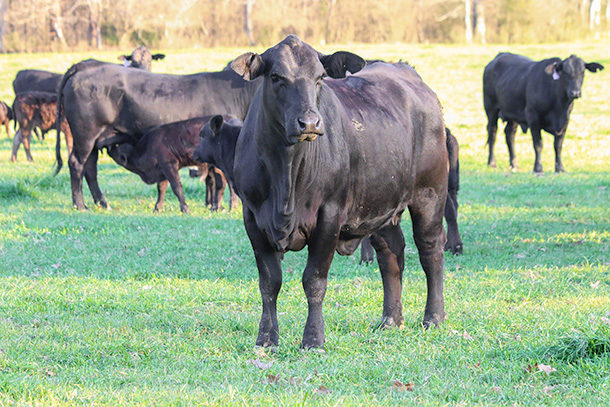While there are several fundamental issues associated with that statement that make it incorrect, at least if taken for face value, there are several factors associated with cow weight that do indeed influence the efficiency of beef cow-calf production.
Nutrient requirements
As a general rule of thumb, nutrient requirements increase as cow weight increases. This is often mistakenly interpreted to mean that because a lighter cow has lower total nutrient requirements, she is also more efficient. The “she is also more efficient” portion of that statement is fundamentally incorrect, for two main reasons. The first is that efficiency is a function of both input and output. Cow bodyweight is neither of those. The second reason is that the efficiency at which nutrients are utilized for maintenance increases as body weight increases. Heavier cows have lower nutrient requirements per unit of bodyweight. Each 100-pound increase in bodyweight corresponds to approximately a 3.5% reduction in nutrient requirements, when expressed per unit of bodyweight. However, the increased efficiency of nutrient use that accompanies the increase in weight is more than offset by a 6% increase in expected forage dry matter intake (DMI) and a disappointingly small (3% to 3.5%) increase in calf weaning weight, all other things created equally.
Body condition
Cow weight increases as body condition increases. A single unit change in body condition represents approximately a 7% change in bodyweight. For example, a cow with a body condition score (BCS) of 6 will be heavier than the same cow with a BCS of 4. For a 1,400-pound cow, that may represent roughly a 200-pound difference in bodyweight. Cow weight can be adjusted for BCS by adding 7.1% of her weight for each single BCS above 5, or by subtracting 7.1% of her weight for each single BCS below 5. Alternatively, BCS-corrected weight can be calculated using the following formula:
BCS-adjusted weight = weight + ((BCS – 5) × weight × 0.071)
Stage of gestation
Weight of a pregnant cow increases with gestation length. Changes in cow weight due to the fetus and pregnant uterus occur independently of changes attributed to body condition. For example, a cow that is eight months bred should weigh considerably more than when she was three months bred. While little additional weight gain occurs during the first trimester of gestation, the weight of the fetus and pregnant uterus may account for an increase in cow weight by upward of 15% to 20% by the end of the third trimester.
Evaluating productivity as a function of cow weight
While not truly a measurement of efficiency, evaluating calf weaning weight as a percentage of cow weight is a preferred and often valuable method of evaluating cow productivity. When doing so, it is important to also consider the factors that influence cow weight, such as body condition and stage of gestation. If calf weaning weight as a percentage of cow weight is used as a selection criterion, then not considering those factors could unintentionally favor thin, hard-doing cows that become pregnant later in the breeding season and therefore have an extended calving season. One way to avoid this bias is to use BCS-adjusted weights. This allows for an apples-to-apples rather than an apples-to-oranges comparison. This is an important consideration because a BCS 4 cow may be perceived to wean far more of her weight when compared to the same cow at a BCS of 6.
For example, that 1,400-pound cow that weans a 640-pound calf at a BCS of 6 would only weigh 1,200 pounds at a BCS of 4. As a result, she would have been calculated to wean 53% of her weight, while the BCS 6 cow would have been calculated to wean only 46%. Similarly, not adjusting relatively high BCS cows could result in selecting against easy-doing females that are paired well to their environment.
An alternative to adjusting weights to a common BCS is to weigh all cows in the herd at the same production milestone. Weighing cows at branding time, the beginning of the breeding season or at weaning may all be acceptable alternatives. This is an important consideration when making across-herd comparisons or within herd but across-time comparisons. One could easily make values more attractive on paper when comparing cows that were weighed at the time of weaning to cows weighed at the time of calving.
Ultimately, a great deal of useful information can be gained by better understanding the major factors that influence cow weight. Since cow weight is typically related to nutrient requirements and voluntary forage intake, it is one of the major cattle-related factors that influences an operation’s carrying capacity. And while cow weight does not directly translate to cow production efficiency, getting a grip on the factors that influence cow weight will help you to optimize productivity of your cow herd. ![]()
PHOTO: Cow weight is one of the major cattle-related factors that influences an operation’s carrying capacity. Staff photo.
-
Jason Smith
- Assistant Professor
- Extension Beef Cattle Specialist
- Department of Animal Science
- Texas A&M AgriLife Extension
- Email Jason Smith








